Mission profiles of 7K-L1 flights
By Richard S Flagg and Sven Grahn
Abstract
This article is an attempt to
analyse the flight profiles of all known launches in the 7K-L1 program
(a.k.a Zond) in order to find the launch constraints and to see if all
missions fit the same pattern of constraints. The analysis is an update
and extension of ref (1).
The conclusion is that there
were at least three constraints:
-
Age of the Moon,
-
Declination phase of the moon
and
-
Opening angle between the moon's
orbit and the transfer orbit.
Two launch attempts (that both
failed) do not fit the pattern: 22 April 1968 and 20 January 1969.
Basic data for the analysis
The table below summarizes the
data used in this analyses. The source for launch times is Vladimir Agapov
and Igor Lissov (2) and the other data have
been computed by the authors.
| Mission |
Launch date |
Launch time
UT |
Launch time
(Decimal UT) |
Age of
moon at
launch |
Decl.
Phase |
Opening
angle |
Remarks |
| Kosmos 146 |
1967 March 10 |
1130:33 |
0.479 |
28.86 |
344.6 |
- |
7K-L1 No. 2P |
| Kosmos 154 |
1967 April 8 |
0900:33 |
0.376 |
28.14 |
2.17 |
- |
7K-L1 No. 3P |
| - |
1967 Sep 27 |
2211:54 |
0.925 |
23.14 |
109 |
29.4 |
7K-L1 No. 4L |
| - |
1967 Nov 22 |
1907:59 |
0.797 |
19.94 |
128 |
28.3
|
7K-L1 No. 5L |
| Zond 4 |
1968 March 2 |
1829:23 |
0.770 |
3.48 |
18 |
- |
7K-L1 No. 6L |
| - |
1968 Apr 22 |
2301:27 |
0.960 |
24.93 |
28 |
73.7 |
7K-L1 No. 7L |
| - |
1968 Jul 14 |
- |
- |
- |
- |
- |
7K-L1 No. 8L |
| Zond 5 |
1968 Sep 14 |
2142:11 |
0.904 |
22.04 |
80 |
34.3 |
7K-L1 No. 9L |
| Zond 6 |
1968 Nov 10 |
1911:31 |
0.799 |
20.06 |
108 |
29.6
|
7K-L1 No. 12L |
| - |
1969 Jan 20 |
0414:36 |
0.177 |
1.98 |
-35 |
74.9
|
7K-L1 No. 13L |
| Zond 7 |
1969 Aug 7 |
2348:06 |
0.992 |
24.39 |
78 |
36.3
|
7K-L1 No. 11L |
| Zond 8 |
1970 Oct 20 |
1955:39 |
0.830 |
20.18 |
105 |
31.8
|
7K-L1 No. 14L |
Zond launch times
The launch time and Age information
makes it possible to determine whether or not a particular launch was aimed
at the moon or not (see "How to compute
the launch time of a lunar probe"). The figure below shows that
all launches except Kosmos 146, Kosmos 165 and Zond 4 were aimed at the
moon. The two Kosmos launches were attempts at testing basic systems of
the L1 system and Kosmos 146 entered a very elliptical orbit (parameters
not known) while Kosmos 154 was stranded in low earth orbit. It was probably
also intended to go into an elliptical orbit after firing of the Block-D
stage. All launches except the 20 January 1969 launch took place at a lunar
Age between 20 days and 25 days, a rather narrow "window"!. The Jan '69
launch occurred at Age = 2 days.
Another very odd conclusion
is that the first Zond attempts were clearly aimed at the Moon, and then,
all of a sudden, Soviet mission planners became cautious and launched
Zond 4 away from the Moon just to test communications and re-entry techniques.
Very
strange!
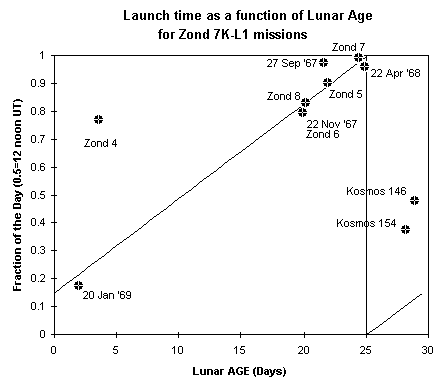
Age of the moon at arrival
The spacecraft arrived at the
Moon between Age 23.3-28.3 days, i.e. very near new moon. The sun was therefore
behind the moon, so by looping around the moon the Zond crew would have
observed the far side of the moon. One can speculate that the Zond spacecraft
flew towards the moon and back in the attitude shown in the figure below.
Possibly, the choice of near alignment between the sun-Moon and Moon-Earth
vector helped simplify the trajectory by minimizing solar gravity perturbations
of the flight path.
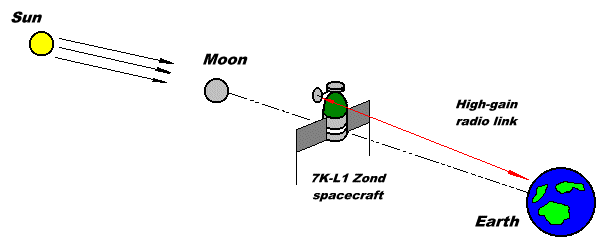
The concept of "declination
phase"
There is an another important
parameter that seems to define Zond launch windows, the declination phase.
Each month as the moon orbits the earth its declination varies in a near-sinusoidal
manner as shown in figure A below. The maximum declination reached
each month is not constant and can vary by ten degrees over the course
of several years. This is shown in figure B where declination plots
for two different months are given. The plots have been aligned in phase
and a new variable termed declination phase (DF) has been introduced as
a measure of time. because of the cyclic variation in declination each
month the maximum northern value of declination is reached when DF=90 degrees
and the maximum southern declination is reached when DF=270 degrees regardless
of the maximum monthly swing in declination. Declination phase which varies
from 0 to 360 degrees serves a a normalized representation of lunar declination
and allows the comparison of lunar flights occurring years apart when the
the monthly maximum declination values were significantly different.
 The moon's location may be specified
in terms of two variables; age (A) and declination phase (DF). A plot of
the moon's motion in the A,DF plane during a typical lunation is shown
below. The trajectory of the moon on the A, DF plane is not the same for
all lunations. In general, every lunation follows a parallel but different
track. If all lunations for several years are plotted then the whole area
of the A,DF plane becomes filled.
The moon's location may be specified
in terms of two variables; age (A) and declination phase (DF). A plot of
the moon's motion in the A,DF plane during a typical lunation is shown
below. The trajectory of the moon on the A, DF plane is not the same for
all lunations. In general, every lunation follows a parallel but different
track. If all lunations for several years are plotted then the whole area
of the A,DF plane becomes filled.
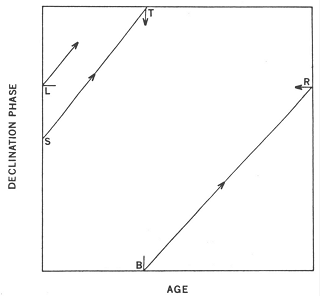
Declination phase at Zond
launches
Of the eight launches aimed
at the moon six took place when the declination phase of the moon at launch
was between 78 degrees and 128 degrees. This means that most Zonds flew
towards the moon when it was near its "northern apex" in its orbit around
the earth. One can speculate that this choice of trajectory would make
it easier to track the mission from northern hemisphere ground stations.
But it could also have something to do with the re-entry trajectory definition.
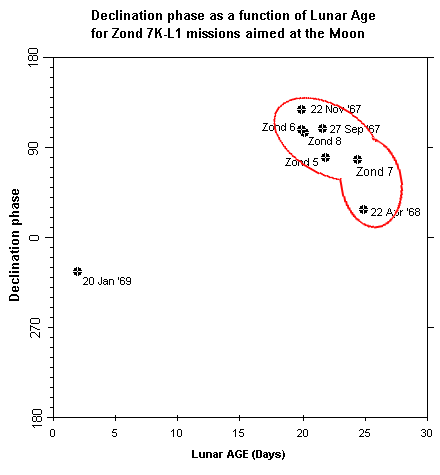
It is also interesting to
note that not all lunations actually pass through the area marked in the
figure above. During the years 1967-1970 the following lunations (months)
did not "pass through" the Zond Decl.phase/Age "window":
| Periods outside
"Zond window" |
| Year |
Start |
End |
| 1967 |
7 Jan |
30 June |
| 1968 |
28 Feb |
24 July |
| 1969 |
18 Jan |
15 July |
| 1970 |
7 Jan |
4 June |
During these periods the
two conditions that the age should permit viewing the far side of the moon
and that the declination of the moon should be high are not fulfilled.
Opening angle - yet another
launch constraint!
It appears that not only were
age and declination phase important but also that the Zonds had to be launched
at a very restricted time when the parking orbit and the moon's orbit were
most nearly co-planar. Let us assume that the moon's orbit is co-planar
with the ecliptic. The parking orbit of the Zonds had an inclination of
51.6 degrees. Depending on the launch time the angle between the orbital
plane and the ecliptic (opening angle) varies between 51.6+23.5=75.1degrees
and 51.6-23.5=28.1 degrees. The figure below shows a plot of the opening
angles for Proton launched Soviet lunar missions. All Zond flights are
tightly grouped near the minimum opening angle while the Sample-return
missions cluster near the maximum. The reason for choosing the minimum
opening angle for the Zonds could be that this condition minimized the
perturbations to the trajectory caused by the moon. It can be shown that
if the opening angle condition is combined with the Age and declination
phase conditions there were no Zond launch opportunities between January
and August 1969.
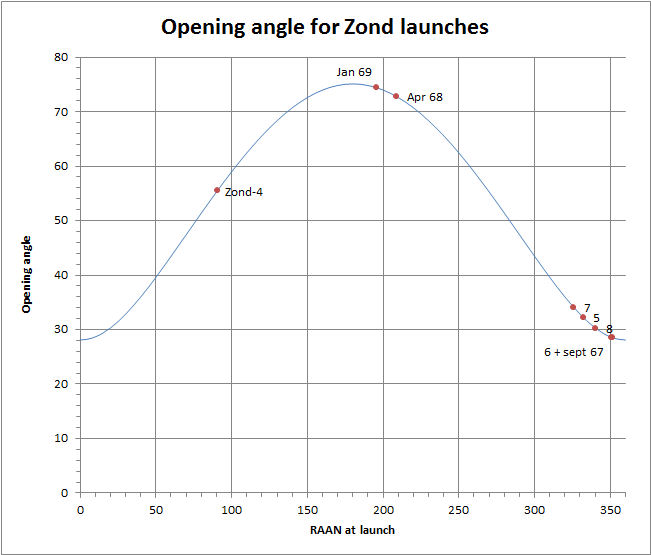
Two strange launches
and the December 1968 launch window
Two launches stand out as deviating
from a pattern. They are the 22 April 1968 launch and the launch on 20
January 1969. The April 1968 launch is near the "main group" in terms of
declination phase, but the January 1969 launch leads to an approach from
a southern declination of the moon - a violation of the constraints defined
by all other Zond missions! Both mission have an opening angle near the
maximum possible instead of near the minimum possible (see
"Basic data for the analysis")! Any ideas
as to why the April 1968 and January 1969 launches deviate so much from
the main group are welcome. Clearly the advantageous launch
windows had passed by that time. Especially the December 1968 launch window
when everyone expected a launch had passed. The launch window opened
during 9-14 December (Age=20-25) 1968, well in advance of Apollo 8!
References
-
Richard
S. Flagg, Soviet Lunar Exploration - An Astronomical Perspective,
Annex to chapter 2 of "Soviet Space Programs: 1981-1987, Part 2" written
by the Congressional Research Service, the Library of Congress, for the
Committee on Commerce, Science and Transportation, United States Senate,
1989. pp 363-391.
-
Igor Lissov,
e-mail dated 29 Dec 2005 about launch time for the 22 April 1968
flight.

 Back
to Space History Notes
Back
to Space History Notes






